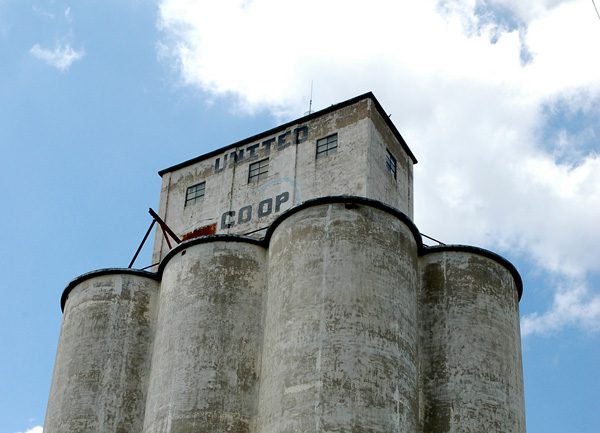
[dropcap]Glimmering[/dropcap] white, the state’s grain elevators thrust upward into pale blue skies across Oklahoma, dotting her landscape with the Plains’ version of castles or cathedrals. Now these iconic symbols have begun to fade away.
Most of the state’s concrete elevators were built between the 1920s and the 1950s; most were finished with a coating of brilliant white paint. It was a one-time application, and most of the elevators have never been repainted.
The staff at Orienta’s grain elevator remembers when one elevator was re-painted in 1978. Five-gallon paint cans littered the grounds. The bill for the new paint job exceeded the cost of the original construction of the elevator.
“The cost is pretty prohibitive to have them painted,” says R.J. Gray, executive director for the Oklahoma Agricultural Cooperative Council.
The Oklahoma Feed and Grain Association says roughly 200 active grain elevators are in the state, including some 160 concrete elevators. Most of Oklahoma’s concrete elevators were constructed by Borton Construction, a firm based in Hutchison, Kan. In the 1930s, the firm built 22 of the massive structures in Oklahoma. The last grain elevator the firm built in Oklahoma was in Durant in 2003.[pullquote]“The last couple of years have seen some of the poorest harvests in state history.”[/pullquote]
“It’s been decades since we received an order to re-paint a grain elevator,” Borton spokesman Pat Augustine says.
The last paint job performed by the firm was in Florida in 1998.
Augustine says Borton bases the cost of a paint job for a grain elevator on the surface square footage. The firm uses an oil-based outdoor paint, and each order requires two coatings.
Augustine notes that demand for concrete construction for grain elevators in Oklahoma has dramatically dropped due to the cost effectiveness of erecting steel bins for wheat storage.
The cost factor for repainting the iconic symbols of Oklahoma agriculture does not spare those on the list of the National Register of Historical Places.
Jackie Anderson, a spokesman for Archer Daniels Midland, says there are no plans to repaint the twin Union Equity Y and Z elevators on the north side of Enid. Built by Borton in 1951 and 1954, respectively, the twin elevators have a storage capacity of 31.6 million bushels of wheat. Illinois-based ADM purchased the twin elevators in 2003. The mammoth elevators were added to the National Register of Historic Places in 2009.
Though rural Oklahoma is enjoying an economic boom from oil and natural gas production, the same cannot be said for segments of the state’s agriculture.
“They just don’t have the money available for things like painting their elevators,” says Joe Hampton, president of the Oklahoma Grain and Feed Association. “The last couple of years have seen some of the poorest harvests in state history.”
There is an outside chance some of Oklahoma’s elevators may see a facelift.
Louisiana-based Consolidated Grain and Barge took ownership of 19 grain elevators from W.B. Johnston Grain in April; more than 15 of the elevators are in Oklahoma. Mark Cruse, director of grain operations, says it is up to local managers to request improvements and maintenance for their grain sites, but the firm takes the appearance and upkeep of its facilities seriously.
“The cost of repainting them, that will have to be digested here,” Cruse says.

























